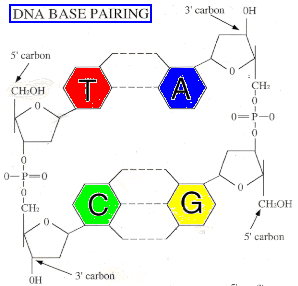DNA 101 - What is it?
DNA (Deoxyribonucleic acid) is a chemical structure that forms
chromosomes.
A piece of a chromosome that dictates a particular trait is called a gene.
Structurally, DNA is a double helix: two strands of genetic material
spiraled
around each other. Each strand contains a sequence of bases (also called
nucleotides). A base is one of four chemicals (adenine, guanine, cytosine
and
thymine).
The two strands of DNA are connected at each base. Each base will only
bond
with one other base, as follows: Adenine (A) will only bond with
thymine (T), and guanine (G) will only bond with cytosine (C). Suppose one
strand of DNA
looks like this:
A-A-C-T-G-A-T-A-G-G-T-C-T-A-G
The DNA strand bound to it will look like this:
T-T-G-A-C-T-A-T-C-C-A-G-A-T-C
Together, the section of DNA would be represented like this:
T-T-G-A-C-T-A-T-C-C-A-G-A-T-C
A-A-C-T-G-A-T-A-G-G-T-C-T-A-G
DNA strands are read in a particular direction, from the top (called the
5'
or "five prime" end) to the bottom (called the 3' or "three prime" end).
In a double helix, the strands go opposite ways:
5' T-T-G-A-C-T-A-T-C-C-A-G-A-T-C 3'
3' A-A-C-T-G-A-T-A-G-G-T-C-T-A-G 5'
The chemical structure of DNA is as follows:

 NEXT
TOPIC: What is DNA Fingerprinting?
NEXT
TOPIC: What is DNA Fingerprinting?
BACK TO TABLE OF CONTENTS
